|
|

CubismCubism is one of the most radical and innovative movements in modern art. We have seen that one trait of modernism is the rejection of illusion; the optical reality that we all experience in normal perception is sacrificed in cubism and replaced with a new abstract "reality." Cubists attempt to explore pure form and are uninterested in feelings as expressionists were. The joint founders of cubism were the Spanish artist Pablo Picasso (1881-1973) and the French artist Georges Braque (1882-1963), both of whom began as traditional artists. Picasso is generally recognized as the giant of modern artists, since he went on to reinvent himself and art in myriad ways.Picasso was trained as a classical painter by his artist father. The works below were done when Picasso was still in his teens. | ||
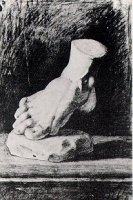
|
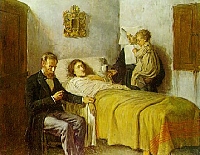 |
left: Study of a Foot, 1894 and center: Science and Charity, 1897 |
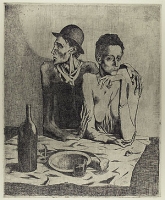
|
The Frugal Repast, etching, 1904Picasso's early works illustrate his sympathy with the poor. He is also searching for new ways to express forms, as we have already seen in his early self portrait. | |
| Picasso's landmark painting, actually known for years by only his closest friends, is | ||
| This is Picasso's first step toward a new style, eventually called "analytic cubism." It depicts a traditional subject in French art--nude females, but these are women of the brothel ("demoiselle" is a euphemism in French for prostitute) and these bold, staring women are hardly the passive, accessible nudes of traditional works.The style is also radical. In analytical cubism, the object is seen from multiple viewpoints simultaneously. Here shapes are fractured into sharp curves and angles and jagged areas represent both the space between forms and forms themselves. Space is flattened and heads are like masks. | 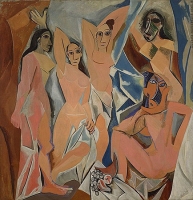
| |
Picasso and Braque worked side by side to develop analytical cubism. In their works forms are broken down and analyzed into parts. Detail is usually eliminated and basic forms are emphasized. In general the paintings seem two-dimensional. In this respect Cézanne's works led the way. (Recall his painting of Saint Victoire.)
Left: Braque, Houses at L'Estaque, 1908; center: Picasso, Portrait of Ambrose Vollard , 1910; right: Braque, The Portuguese, 1911 | ||
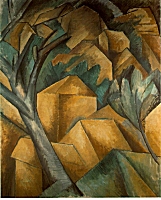
|
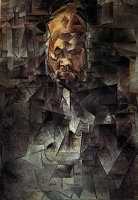
|
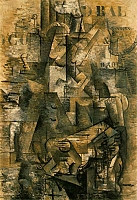
|
| Picasso and Braque then developed a new variant of cubism, so-called synthetic cubism. In this version works are not as abstract but more clearly related to reality. The works are also often more colorful. Still objects are only suggested and the artists play visual games: they ask us what is real and what is illusion or represented. These works often use collage (or separate elements from the real world--cut paper pasted together, often mass-produced objects like wall-paper). Collage becomes a way of rejected "high art" and embracing the popular and ordinary. | ||
Picasso, Still Life with Chair Caning, 1912Here a piece of oilcloth with caning imprinted on it is the "background" for the painting. A real piece of rope frames the work. But the chair caning seems real and the painted objects seem to extend beyond the background. |
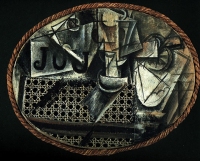
| |
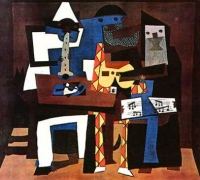
|
PicassoOn the left we see another version of "synthetic cubism" with bright colors and a vague reference to reality, even with jig-saw puzzle shapes. | |
Picasso continued to develop his art in various ways, sometimes returning to representation, sometimes altering his versions of the human figure style, sometimes trying new media.Left: The Dream, 1932; center: Baboon and Young, bronze, cast after found objects (a toy car for the head), 1950; right: Head of a Woman, Chicago Civic Center, 1964 | ||
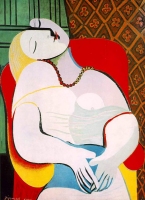
|
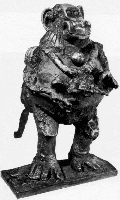
|
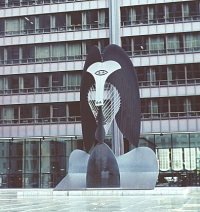
|
| Picasso's most moving work is described in Gardner's Art Through the Ages: "The greatest twentieth-century painting inspired by outrage directed toward brutal human behavior is Guernica, created by Pablo Picasso in 1937 in response to the saturation bombing of an ancient Basque city by German forces acting for the rebel general Francisco Franco during the Spanish Civil War" (1088). In this large painting (almost 26 feet long) Picasso uses the synthetic cubist style to depict a nightmare world of fear and death. | ||

|
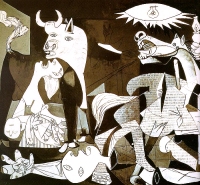
|
Picasso |
| Although the avant-garde style of Cubism upset the public, it proved to be a fruitful direction for a number of modern
artists. | ||
French CubistsFernande Léger (1881-1955), The Cardplayers, 1917 and Robert Delaunay (1885-1941), Simultaneous Contrasts: Sun and Moon, 1913 |
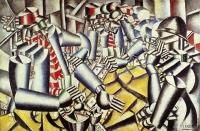
|
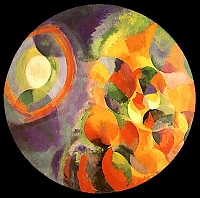
|
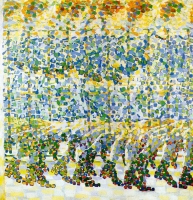
|
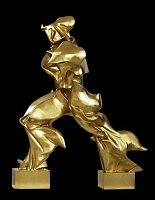
|
Italian CubistsGiacomo Balla (1871-1958), Young girl Running on a Balcony, 1912 and Umberto Boccioni (1882-1916), Unique Forms of Continuity in Space, bronze, 1913 |
American CubistsStuart Davis (1894-1964), Report from Rockport, 1940 and African American artist Aaron Douglas (1899-1979), In an African Setting, 1934 |
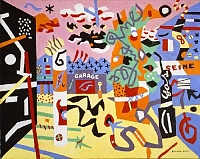
|
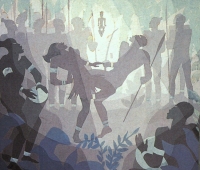
|
Synthetic cubism also inspired new approaches to sculpture. Instead of defining the figure by enclosed masses, cubist sculptors may use negative space as part of the design. (See the head below.) Although cubist sculpture may be somewhat representational, it often presents its subject in terms of forms, planes, and separate volumes. | ||
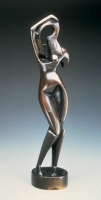
|
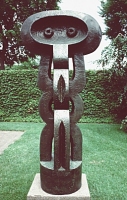
|
Alexander Archipenko (1887-1964), Woman Combing her Hair, 1915 and Jacques Lipchitz (1891-1973), Figure, 1926-30 |
| Work cited: Richard G. Tansey and Fred S. Kleiner. Gardner's Art Through the Ages. Tenth Edition. New York: Harcourt Brace, 1996. | ||
All images marked MAS were photographed on location by Mary Ann Sullivan. All other images were scanned from other sources or downloaded from the World Wide Web; they are posted on this password-protected site for educational purposes, at Bluffton College only, under the "fair use" clause of U.S. copyright law.